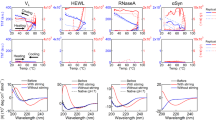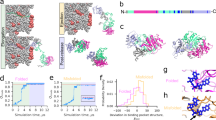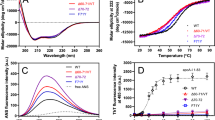Abstract
We have systematically studied the effects of 40 single point mutations on the conversion of the denatured form of the α/β protein acylphosphatase (AcP) into insoluble aggregates. All the mutations that significantly perturb the rate of aggregation are located in two regions of the protein sequence, residues 16–31 and 87–98, each of which has a relatively high hydrophobicity and propensity to form β-sheet structure. The measured changes in aggregation rate upon mutation correlate with changes in the hydrophobicity and β-sheet propensity of the regions of the protein in which the mutations are located. The two regions of the protein sequence that determine the aggregation rate are distinct from those parts of the sequence that determine the rate of protein folding. Dissection of the protein into six peptides corresponding to different regions of the sequence indicates that the kinetic partitioning between aggregation and folding can be attributed to the intrinsic conformational preferences of the denatured polypeptide chain.
This is a preview of subscription content, access via your institution
Access options
Subscribe to this journal
Receive 12 print issues and online access
$189.00 per year
only $15.75 per issue
Buy this article
- Purchase on Springer Link
- Instant access to full article PDF
Prices may be subject to local taxes which are calculated during checkout






Similar content being viewed by others
References
Fink, A.L. Protein aggregation: folding aggregates, inclusion bodies and amyloid. Folding Des. 3, R9–R23 (1998).
Dobson, C.M. Protein misfolding, evolution and disease. Trends Biochem. Sci. 24, 329–332 (1999).
Raso, S.W. & King, J. In Mechanisms of protein folding. 2nd edn (ed. Pain, R.H.) 406–428 (Oxford University Press, Oxford; 1999).
Leroux, M.R. & Hartl, F.U. In Mechanisms of protein folding. 2nd edn (ed. Pain, R.H.) 364–405 (Oxford University Press, Oxford; 1999).
Kelly, J.W. Alternative conformations of amyloidogenic proteins govern their behavior. Curr. Opin. Struct. Biol. 6, 11–17 (1996).
Dobson, C.M. The structural basis of protein folding and its links with human disease. Philos. Trans. R. Soc. Lond. B. Biol. Sci. 356, 133–145 (2001).
Mattson, M.P., Pedersen, W.A., Duan, W., Culmsee, C. & Camandola S. Cellular and molecular mechanisms underlying perturbed energy metabolism and neuronal degeneration in Alzheimer's and Parkinson's diseases. Ann. NY Acad. Sci. 893, 154–175 (1999).
Yankner, B.A., Duffy, L.K & Kirschner, D.A. Neurotrophic and neurotoxic effects of amyloid β protein: reversal by tachykinin neuropeptides. Science 250, 279–282 (1990).
Varadarajan, S., Yatin, S., Aksenova, M. & Butterfield, D.A. Review: Alzheimer's amyloid β-peptide-associated free radical oxidative stress and neurotoxicity. J. Struct. Biol. 130, 184–208 (2000).
Pastore, A., Saudek, V., Ramponi, G. & Williams, R.J.P. Three-dimensional structure of acylphosphatase. Refinement and structure analysis. J. Mol. Biol. 224, 427–440 (1992).
Chiti, F. et al. Designing conditions for in vitro formation of amyloid protofilaments and fibrils. Proc. Natl. Acad. Sci USA 96, 3590–3594 (1999).
Chiti, F. et al. Mutational analysis of the propensity for amyloid formation by a globular protein. EMBO J. 19, 1441–1449 (2000).
Matouschek, A., Kellis, J.T., Serrano, L. & Fersht, A.R. Mapping the transition state and pathway of protein folding by protein engineering. Nature 340, 122–126 (1989).
Fersht, A.R. In Structure and mechanism of protein science. A guide to enzyme catalysis and protein folding. 540–572 (W.H. Freeman & Co., New York; 1999).
Grantcharova, V., Alm, E.J., Baker, D. & Horwich, A.L. Mechanisms of protein folding. Curr. Opin. Struct. Biol. 11, 70–82 (2001).
Gunasekaran, K., Eyles, S.J., Hagler, A.T. & Gierasch, L.M. Keeping it in the family: folding studies of related proteins. Curr. Opin. Struct. Biol. 11, 83–93 (2001).
Hurle, M.R., Helms, L.R., Li, L., Chan, W. & Wetzel, R.A. A role for destabilising amino acid replacements in light chain amyloidosis. Proc. Natl. Acad. Sci. USA 91, 5446–5450 (1994).
McCutchen, S.L., Lai, Z.H., Miroy, G.J., Kelly, J.W. & Colon, W. Comparison of lethal and nonlethal transthyrethin variants and their relationship to amyloid disease. Biochemistry 34, 13527–13536 (1995).
Ramirez-Alvarado, M., Merkel, J.S. & Regan L. A systematic exploration of the influence of the protein stability on amyloid fibril formation in vitro. Proc. Natl. Acad. Sci. USA 97, 8979–8984 (2000).
Main, E.R. & Jackson, S.E. Does trifluoroethanol affect folding pathways and can it be used as a probe of structure in transition states? Nature Struct. Biol. 6, 831–835 (1995).
Harper, J.D, Lieber, C.M. & Lansbury, P.T. Jr. Atomic force microscopic imaging of seeded fibril formation and fibril branching by the Alzheimer's disease amyloid-β protein. Chem. Biol. 4, 951–959 (1997).
Conway, K.A., Harper, J.D. & Lansbury, P.T. Jr. Fibrils formed in vitro from α-synuclein and two mutant forms linked to Parkinson's disease are typical amyloid. Biochemistry 39, 2552–2563 (2000).
King, C.Y. Supporting the structural basis of prion strains: induction and identification of [PSI] variants. J. Mol. Biol. 307, 1247–1260 (2001).
Betts, S. & King, J. There's a right way and a wrong way: in vivo and in vitro folding, misfolding and subunit assembly of the P22 tailspike. Structure Fold. Des. 7, R131–R139 (1999).
Blanco, F.J, Rivas, G. & Serrano, L. A short linear peptide that folds into a native stable β-hairpin in aqueous solution. Nature Struct. Biol. 1, 584–590 (1994).
Roseman, M.A. Hydrophilicity of polar amino acid side-chains is markedly reduced by flanking peptide bonds. J. Mol. Biol. 200, 513–22 (1988).
Lacroix, E., Viguera, A.R. & Serrano, L. Elucidating the folding problem of α-helices: local motifs, long-range electrostatics, ionic-strength dependence and prediction of NMR parameters. J. Mol. Biol. 284, 173–191 (1998).
Street, A.G. & Mayo, S.L. Intrinsic β-sheet propensities result from van der Waals interactions between side chains and the local backbone. Proc. Natl. Acad. Sci. USA 96, 9074–9076 (1999).
Villegas, V et al. Protein engineering as a strategy to avoid formation of amyloid fibrils. Protein Sci. 9, 1700–1708 (2000).
Kallberg, Y., Gustafsson, M., Persson, B., Thyberg, J., Johansson, J. Prediction of amyloid fibril-forming proteins. J. Biol. Chem. 276, 12945–12950 (2001).
Wood, S.J., Wetzel, R., Martin, J.D. & Hurle, M.R. Prolines and amyloidogenicity in fragments of the Alzheimer's peptide β/A4. Biochemistry 34, 724–730 (1995).
Chiti, F. et al. Mutational analysis of AcP suggests the importance of topology and contact order in protein folding. Nature Struct. Biol. 6, 1005–1010 (1999).
Vendruscolo, M., Paci, E., Dobson, C.M. & Karplus, M. Three key residues form a critical contact network in a transition state for protein folding. Nature 409, 641–645 (2001).
Smith, L.J., Fiebig, K.M., Schwalbe, H. & Dobson, C.M. The concept of a random coil. Residual structure in peptides and denatured proteins. Folding Des. 1, R95–R106 (1996).
Neira, J.L. & Fersht, A.R. Acquisition of native-like interactions in C-terminal fragments of barnase. J. Mol. Biol. 287, 421–432 (1999).
Sinclair, J.F. & Shortle, D. Analysis of long-range interactions in a model denatured state of staphylococcal nuclease based on correlated changes in backbone dynamics. Protein Sci. 8, 991–1000 (1999).
Zhang, O. & Forman-Kay, J.D. NMR studies of unfolded states of an SH3 domain in aqueous solution and denaturing conditions. Biochemistry 36, 3959–3970 (1997).
Redfield, C., Schulman B.A., Milhollen, M.A., Kim, P.S. & Dobson, C.M. α-lactalbumin forms a compact molten globule in the absence of disulfide bonds. Nature Struct. Biol. 6, 948–952 (1999).
Dobson, C.M., Sali, A. & Karplus, M. Protein folding: A perspective from theory and experiment. Angew. Chem. Int. Ed. 37, 868–893 (1998).
Neira, J.L. et al. Following co-operative formation of secondary and tertiary structure in a single protein module. J. Mol. Biol. 268, 185–197 (1997).
Kortemme, T., Kelly; M.J., Kay, L.E., Forman-Kay, J. & Serrano, L. Similarities between the spectrin SH3 domain denatured state and its folding transition state. J. Mol. Biol. 297, 1217–1229 (2000).
Swietnicki, W., Petersen, R.B., Gambetti, P. & Surewicz, W.K. Familial mutations and the thermodynamic stability of the recombinant human prion protein. J. Biol. Chem. 273, 31048–31052 (1998).
Liemann, S. & Glockshuber R. Influence of amino acid substitutions related to inherited human prion diseases on the thermodynamic stability of the cellular prion protein. Biochemistry 38, 3258–3267 (1999).
Otzen, D.E., Kristensen, O. & Oliveberg, M. Designed protein tetramer zipped together with a hydrophobic Alzheimer homology: a structural clue to amyloid assembly. Proc. Natl. Acad. Sci. USA 97, 9907–9912 (2000).
Baker, D. A surprising simplicity to protein folding. Nature 405, 39–42 (2000).
Taddei, N. et al. Looking for residues involved in muscle acylphosphatase catalytic mechanism and structural stabilization: the role of Asn 41, Thr 42 and Thr 46. Biochemistry 35, 7077–7083 (1996).
Taddei, N. et al. Stabilisation of α-helices by site-directed mutagenesis reveals the importance of secondary structure in the transition state for acylphosphatase folding. J. Mol. Biol. 300, 633–647 (2000).
Gill, S.C. & von Hippel, P.H. Calculation of protein extinction coefficients from amino acid sequence data. Anal. Biochem. 182, 319–326 (1989).
Naiki, H. & Nakakuki, K. First-order kinetic model of Alzhaimer's β-amyloid fibril extension in vitro. Lab. Invest. 74, 374–383 (1996).
Friedhoff, P., von Bergen, M., Mandelkow, E. -M. & Mandelkow, E. A nucleated assembly mechanism of Alzheimer paired helical filaments. Proc. Natl. Acad. Sci. USA 95, 15712–15717 (1998).
Taylor, J.R. Introduction to error analysis, the study of uncertainties in physical measurements. (University Science Books, Sausalito, California; 1982).
Acknowledgements
We are very grateful for support from the Accademia Nazionale dei Lincei (F.C.), the Fondazione Telethon-Italia (F.C.) and the Wellcome Trust (C.M.D.). The OCMS is supported by the BBSRC, the EPSRC and the MRC. The DSB in Florence is supported by the Italian CNR and the Fondazione Telethon-Italia. The authors thank the Centro Interdip. from the University of Florence for assistance in mass spectrometry; and M. Vendruscolo, K. Plaxco, M. Karplus and A. Fersht for stimulating discussions.
Author information
Authors and Affiliations
Corresponding author
Ethics declarations
Competing interests
The authors declare no competing financial interests.
Rights and permissions
About this article
Cite this article
Chiti, F., Taddei, N., Baroni, F. et al. Kinetic partitioning of protein folding and aggregation. Nat Struct Mol Biol 9, 137–143 (2002). https://doi.org/10.1038/nsb752
Received:
Accepted:
Published:
Issue Date:
DOI: https://doi.org/10.1038/nsb752
This article is cited by
-
Disease-specific tau filaments assemble via polymorphic intermediates
Nature (2024)
-
Implications of ALS-Associated Mutations on Biochemical and Biophysical Features of hSOD1 and Aggregation Formation
Biochemical Genetics (2024)
-
Mechanisms and pathology of protein misfolding and aggregation
Nature Reviews Molecular Cell Biology (2023)
-
A dual-reporter system for investigating and optimizing protein translation and folding in E. coli
Nature Communications (2021)
-
Protein aggregation: in silico algorithms and applications
Biophysical Reviews (2021)



